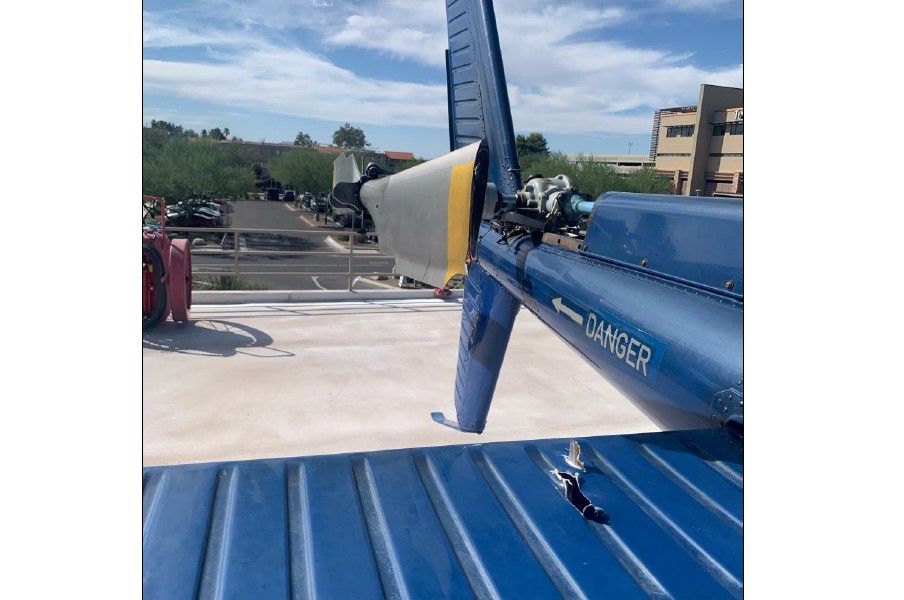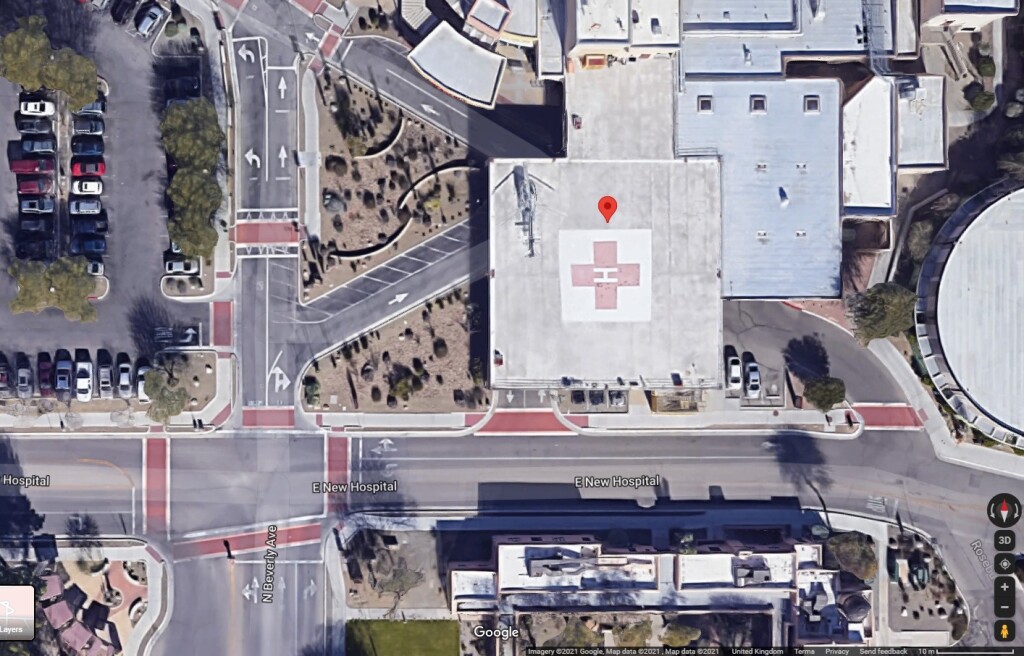Air Methods AS350B3 Air Ambulance Tail Strike at Tucson Medical Center, AZ (N544AM)
On 16 October 2021 an Air Methods Corp (AMC) helicopter air ambulance Airbus Helicopters AS350B3, N544AM, suffered a tail rotor strike on landing on an elevated helidpad at Tucson Medical Center, Arizona. The four occupants were uninjured. The US National Transportation Safety Board (NTSB) has released a brief preliminary report and (on 21 December 2021) a short public docket. The helicopter was transporting a patient in daylight from Nogales, Arizona. The pilot had flown 3188 hours, 161 on type. As the helicopter came over the elevated helipad the tail rotor contacted the handle of a large wheeled fire extinguisher.

Air Methods Corp (AMC) Airbus AS350B3 N544AM Tail Rotor Strike Tucson Medical Center Helipad (Credit: via NTSB)
What is noticeable is the extinguisher potion and that the helicopter had landed significantly off centre. The satellite imagery shown in Google Maps suggests this is not uncommon.
Furthermore the extinguisher, which the satellite imagery above suggests is normally in this location (albeit with no apparent ready access or safe space for any waiting ground personnel), is only marginally higher than a series of metal handrails around the helideck shown below.

Air Methods Corp (AMC) Airbus AS350B3 N544AM Tail Rotor Strike Tucson Medical Center Helipad (Credit: via NTSB)
There is no perimeter netting to minimise obstructions as is common elsewhere (e.g.: UK CAA CAP1264: Standards for helicopter landing areas at hospitals). One would hope the safety investigation considers the layout of hospital’s heliport and the adequacy of the design standards used.
As seen above, not only was the tail rotor damaged but debris impacted the tail boom and punctured the horizontal stabiliser.
In 2017 the FAA changed Part 135 so that helicopter air ambulance operators have to comply with a new Flight Data Monitoring (FDM) System requirement, FAR 135.607. FAA AC 135-14B Helicopter Air Ambulance (HAA) Operations explains that the system…
…should record digital or analog raw data, images, cockpit voice or ambient audio recordings or any combinations thereof which ideally yield at least the following flight information: • Location; • Altitude; • Heading; • Speeds (airspeed and groundspeed); • Pitch, yaw, and roll attitudes and rate of change; • Engine parameters; • Main rotor RPM; • Ambient acoustic data; • Radio ambient audio; and • Any other parameter the operator deems necessary (e.g., high definition video recording looking forward including instrument panel and forward cockpit windshield view, intercommunications system (intercom) between pilot and medical crew, communications with air traffic control (ATC), OCS, base operations, first responders at scene, hospital, etc.)
So a competent and comprehensive safety investigation would have access to extensive data, and other non-volatile memory data (such as GPS data) from the aircraft too, to elevate the approach and determine the effectiveness of the FDM program in routinely monitoring approaches and providing constructive feedback to crews.
NTSB Probable Cause (UPDATE: 29 April 2022)
The NTSB issued this laughably un-insightful probable cause:
The pilot’s failure to maintain clearance from ground equipment during landing.
Safety Resources
The European Safety Promotion Network Rotorcraft (ESPN-R) has a helicopter safety discussion group on LinkedIn. You may also find these Aerossurance articles of interest:
- Air Ambulance B407 Hospital Helipad Deck Edge Tail Strike During Shallow Approach
- South Korean Fire-Fighting Helicopter Tail Rotor Strike on Fuel Bowser
- Air Methods AS350B3 Night CFIT in Snow
- NTSB on LA A109S Rooftop Hospital Helipad Landing Accident
- Air Ambulance Helicopter Fell From Kathmandu Hospital Helipad (Video)
- US Air Ambulance Near Miss with Zip Wire and High ROD Impact at High Density Altitude
- Air Ambulance Helicopter Downed by Fencing FOD
- Ambulance / Air Ambulance Collision
- Beware Last Minute Changes in Plan
- Grand Canyon Air Tour Tragic Tailwind Landing Accident
- A Short Flight to Disaster: A109 Mountain CFIT in Marginal Weather
- US Fatal Night HEMS Accident: Self-Induced Pressure & Inadequate Oversight
- HEMS A109S Night Loss of Control Inflight (N91NM)
- Air Ambulance A109S Spatial Disorientation in Night IMC (N11NM)
- US HEMS EC135P1 Dual Engine Failure: 7 July 2018
- Misassembled Anti-Torque Pedals Cause EC135 Accident
- Taiwan NASC UH-60M Night Medevac Helicopter Take Off Accident
- Fatal Fatigue: US Night Air Ambulance Helicopter LOC-I Accident
- Deadly Dusk Air Ambulance Bird Strike
- HEMS Black Hole Accident: “Organisational, Regulatory and Oversight Deficiencies”
- HEMS S-76C Night Approach LOC-I Incident
- Life Flight 6 – US HEMS Post Accident Review
- US HEMS “Delays & Oversight Challenges” – IG Report
- US HEMS Accident Rates 2006-2015
- More US Night HEMS Accidents
- That Others May Live – Inadvertent IMC & The Value of Flight Data Monitoring
- Fatal US Helicopter Air Ambulance Accident: One Engine was Failing but Serviceable Engine Shutdown
- S-76A++ Rotor Brake Fire
- A HEMS Helicopter Had a Lucky Escape During a NVIS Approach to its Home Base
- UPDATE 22 January 2022: Pedestrian Seriously Injured by Air Ambulance Landing at Melbourne Hospital
- UPDATE 29 April 2022: US Air Ambulance Helicopter Hospital Heliport Tail Strike
- UPDATE 21 January 2023: After Landing this HEMS Helicopter Suddenly Started to Slide Towards it’s Hangar…


Recent Comments